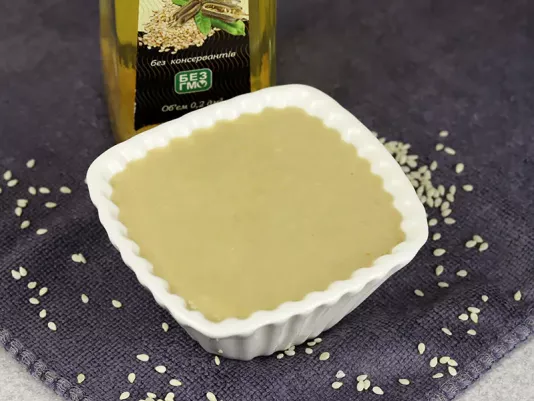Baba Ganoush
Baba Ganoush - Jewish recipe, perfect eggplant and tahini salad.

Tahini is a paste made from ground sesame seeds, which I consider one of the most versatile ingredients in my kitchen. Its taste combines nutty and creamy notes, and its delicate texture allows it to be used in both savory and sweet dishes. With more than thirty years of cooking experience, I have often been convinced that tahini can completely transform a dish: when added to a sauce with lemon juice and garlic, it makes it tender and balanced, and when paired with honey or dates, it becomes the basis for exquisite desserts. I love using tahini in hummus, salad dressings, sauces for meat and fish, as well as in baking – from simple homemade bread to sweet pies. I appreciate that this ingredient has deep traditions in Mediterranean and Middle Eastern cuisine while also fitting easily into modern culinary trends. For me, tahini is a way to diversify the diet and add flavor depth and nutrition to meals without sacrificing lightness and balance.
Tahini has an ancient history, and every time I take a jar of this paste in my hands, I am reminded of how rich the culinary world can be, hidden within simple sesame seeds. This ingredient originated in the Middle East, where sesame seeds were turned into a thick paste thousands of years ago. I am always fascinated by how the traditions of different peoples intertwine around one simple idea – to create a rich, nourishing, and at the same time versatile product. In Mediterranean cuisine, tahini has become an integral part of hummus and sauces, and in modern culinary schools, it is valued for its ability to blend harmoniously with the most diverse ingredients. In my own practice, I have often felt that tahini is a true bridge between cultures: it unites traditional recipes with modern interpretations, giving the opportunity to create dishes that feel both familiar and new. This is how its unique cultural significance is formed – it is not just an ingredient but a symbol of continuity in culinary traditions. For me, tahini has always been an example of how a simple paste can become the foundation for thousands of variations in world cuisine.
When I think of tahini, the first thing that comes to mind is its delicate, creamy texture and rich nutty taste. It differs significantly from other nut or seed pastes: not as sweet as peanut butter, yet not too sharp. This characteristic allows me to use tahini in a wide variety of dishes. Combined with lemon juice and garlic, it becomes the base for a sauce that I often serve with salads, grilled vegetables, or baked fish. In meat dishes, tahini pairs wonderfully with lamb and chicken, adding tenderness and a subtle nutty note. I also enjoy experimenting with sweet recipes: in desserts, the paste enhances the flavor of chocolate, honey, or dried fruits and creates a sense of refined richness. Tahini is especially successful when combined with citrus fruits and pomegranate, adding freshness and contrast to dishes. In my practice, it has proven its versatility: from creamy soups to cookies, from sauces to cocktails. This is an ingredient that does not limit creativity but instead opens countless paths to new combinations. And every time I use it, I know the result will be not only delicious but truly special.
Over the years of cooking, I have been convinced many times that tahini has a unique ability to travel across world cuisines, adapting to different traditions. In Middle Eastern countries, it is the foundation of the famous hummus, which is hard to imagine a daily table without. There I also learned to prepare tahini sauce with lemon juice and garlic – it works perfectly with both vegetables and meat. In the Mediterranean, it is added to sauces for fish and seafood, giving dishes lightness and delicacy. I like that in Asian cuisines, tahini is often combined with soy sauce and ginger – this duo creates an interesting contrast and makes dishes more piquant. In modern European gastronomy, this paste is eagerly used in baking and dessert recipes: I myself have baked cookies, pastries, and even ice cream with tahini, and the result has always amazed my guests. I believe it is this versatility that makes it so popular in different countries. Whether it is a simple homemade dinner or a complex restaurant menu, tahini always has something to offer. For me, it symbolizes the openness of cuisine, where an ingredient with an ancient history becomes part of modern culinary explorations in the most diverse corners of the world.
For many years, I have valued tahini not only for its taste but also for its health benefits. This paste is made from sesame seeds, which are rich in calcium, magnesium, zinc, and iron. Because of this, tahini becomes an excellent addition to the diet of those who care about their bones, muscles, and immune system. In my daily meals, it often serves as a source of plant-based protein, which is especially important for vegetarians. In addition, tahini contains unsaturated fats that help support cardiovascular health, as well as fiber, which has a positive effect on digestion. I have noticed that dishes with tahini provide a feeling of satiety while not weighing down the body, making it a great choice for a balanced menu. In my cooking, I often combine it with vegetables or grains to create nutritious yet light dishes. It is especially beneficial to use tahini with lemon juice – this way, calcium is better absorbed. For me, it is important that this product is both tasty and healthy: it allows me to cook with pleasure while also taking care of well-being. That is why tahini always remains in my kitchen and is considered an indispensable ingredient.